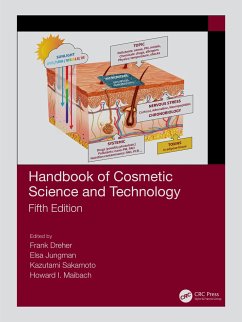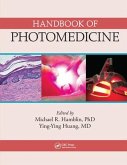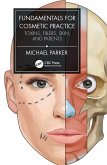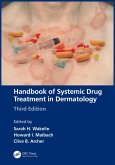Handbook of Cosmetic Science and Technology
Herausgeber: Jungman, Elsa; Sakamoto, Kazutami; Maibach, Howard I.; Dreher, Frank
Handbook of Cosmetic Science and Technology
Herausgeber: Jungman, Elsa; Sakamoto, Kazutami; Maibach, Howard I.; Dreher, Frank
- Gebundenes Buch
- Merkliste
- Auf die Merkliste
- Bewerten Bewerten
- Teilen
- Produkt teilen
- Produkterinnerung
- Produkterinnerung
With chapters from contributors holding positions in research, industry, and clinical practice, this is the fifth edition of what has become the standard reference for cosmetic scientists and dermatologists seeking the latest innovations for the formulation, design, testing, use, and production of cosmetic products for the skin.
Andere Kunden interessierten sich auch für
![Ernsting's Aviation and Space Medicine 5e Ernsting's Aviation and Space Medicine 5e]() Ernsting's Aviation and Space Medicine 5e277,99 €
Ernsting's Aviation and Space Medicine 5e277,99 €![Handbook of Photomedicine Handbook of Photomedicine]() Handbook of Photomedicine63,99 €
Handbook of Photomedicine63,99 €![Fundamentals for Cosmetic Practice Fundamentals for Cosmetic Practice]() Michael ParkerFundamentals for Cosmetic Practice111,99 €
Michael ParkerFundamentals for Cosmetic Practice111,99 €![Clinical Innovation in Rheumatology Clinical Innovation in Rheumatology]() Clinical Innovation in Rheumatology77,99 €
Clinical Innovation in Rheumatology77,99 €![Atlas of Vulvovaginal Disease in Darker Skin Types Atlas of Vulvovaginal Disease in Darker Skin Types]() Atlas of Vulvovaginal Disease in Darker Skin Types109,99 €
Atlas of Vulvovaginal Disease in Darker Skin Types109,99 €![Botulinum Toxins in Clinical Aesthetic Practice 3E, Volume Two Botulinum Toxins in Clinical Aesthetic Practice 3E, Volume Two]() Botulinum Toxins in Clinical Aesthetic Practice 3E, Volume Two172,99 €
Botulinum Toxins in Clinical Aesthetic Practice 3E, Volume Two172,99 €![Handbook of Systemic Drug Treatment in Dermatology Handbook of Systemic Drug Treatment in Dermatology]() Handbook of Systemic Drug Treatment in Dermatology123,99 €
Handbook of Systemic Drug Treatment in Dermatology123,99 €-
-
-
With chapters from contributors holding positions in research, industry, and clinical practice, this is the fifth edition of what has become the standard reference for cosmetic scientists and dermatologists seeking the latest innovations for the formulation, design, testing, use, and production of cosmetic products for the skin.
Hinweis: Dieser Artikel kann nur an eine deutsche Lieferadresse ausgeliefert werden.
Hinweis: Dieser Artikel kann nur an eine deutsche Lieferadresse ausgeliefert werden.
Produktdetails
- Produktdetails
- Verlag: Taylor & Francis Ltd
- 5 ed
- Seitenzahl: 436
- Erscheinungstermin: 11. August 2022
- Englisch
- Abmessung: 286mm x 213mm x 28mm
- Gewicht: 1554g
- ISBN-13: 9780367469979
- ISBN-10: 0367469979
- Artikelnr.: 63200848
- Herstellerkennzeichnung
- Libri GmbH
- Europaallee 1
- 36244 Bad Hersfeld
- gpsr@libri.de
- Verlag: Taylor & Francis Ltd
- 5 ed
- Seitenzahl: 436
- Erscheinungstermin: 11. August 2022
- Englisch
- Abmessung: 286mm x 213mm x 28mm
- Gewicht: 1554g
- ISBN-13: 9780367469979
- ISBN-10: 0367469979
- Artikelnr.: 63200848
- Herstellerkennzeichnung
- Libri GmbH
- Europaallee 1
- 36244 Bad Hersfeld
- gpsr@libri.de
Frank Dreher, PhD, is Founder and President of Topalix LLC, San Francisco, California, USA. Elsa Jungman, PhD, is Founder and CEO of ELSI Skin Health, Inc., San Francisco, California, USA. Kazutami Sakamoto, PhD, is Guest Professor of Pure and Applied Chemistry, Tokyo University of Science, Japan. He is also editor of Cosmetic Science and Technology: Theoretical Principles and Applications. Howard I. Maibach, MD, is Professor of Dermatology at the University of California School of Medicine, San Francisco, California, USA. He is also the editor of Cosmeceuticals and Active Cosmetics 3E, Handbook of Systemic Drug Treatment in Dermatology 2E, Contact Urticaria Syndrome, Textbook of Cosmetic Dermatology 5E, Dermatotoxicology 8E, and Topical Nail Products and Ungual Drug Delivery, among many others.
Biophysical characteristics of skin: Relation to skin of color
age
gender
and site
2.) Skin Moisturization
3.) Skin pH and buffering capacity
4.) Skin ceramides
5.) Sensitive skin: Sensory
clinical
and physiological factors
6.) New developments in understanding of sensitive skin
7.) The role of neuromediators in skin conditions
8.) Contact Dermatitis: Principles
mechanisms
and allergies related to cosmetics
9.) Race as a possible endogenous factor in Irritant Contact Dermatitis: Comparing the irritant response among White
Black
and Asian individuals
10.) Skin aging: Physical and physiological changes
11.) Skin aging: Impact of smoking and air pollution
12.) Skin barrier and transepidermal water loss (TEWL): A critical overview
13.) Skin lipid organization by electron paramagnetic resonance
14.) Determination of skin color in relation to ethnicity
gender
age
site
and environmental factors: An overview
15.) Ultraviolet imaging of skin and cosmetics
16.) Tribology of skin
17.) Formation and performance of cosmetic films in cosmetics
18.) Sensitive skin testing
19.) Neurophysiological responses and cosmetics
20.) Noninvasive clinical assessment of skin inflammation
21.)Validated alternative methods available for human Health and Safety assessment of cosmetic products and their ingredients in the European Union
22.) Pre-clinical human skin models for cosmetic efficacy testing
23.) Skin cleansing: New trends
24.) Removal methods and evaluation of makeup cosmetics
25.) Hydrating substances
26.) Skin care occlusive ingredients: Predicting occlusion's effects using partition coefficients
27.) Antioxidant technology in skin care
28.) Sunscreens and sun protection
29.) Pollution-induced oxidative stress in skin and related potential antioxidant protection
30.) New perspectives in the control of the skin aging process
31.) Epigenetics and cosmetics
32.) Skin lightening agents
33.) Baby care products
34.) Skin care products: Artificial tanning
35.) Skin restoration products after cosmetic procedures
36.) Skin surface pH and its implication in skin health
37.) Formulating Cosmetic Products
38.) Silicones in cosmetics
39.) Plants
plant products
and indigenous practices in cosmetics and skin care
40.) Aquatic environmental impact of cosmetics
41.) Regulatory trends in Cosmetic Dermatology: Europe
42.) Regulatory trends in Cosmetic Dermatology: Singapore
43.) Standardization: ISO and cosmetics
Index
age
gender
and site
2.) Skin Moisturization
3.) Skin pH and buffering capacity
4.) Skin ceramides
5.) Sensitive skin: Sensory
clinical
and physiological factors
6.) New developments in understanding of sensitive skin
7.) The role of neuromediators in skin conditions
8.) Contact Dermatitis: Principles
mechanisms
and allergies related to cosmetics
9.) Race as a possible endogenous factor in Irritant Contact Dermatitis: Comparing the irritant response among White
Black
and Asian individuals
10.) Skin aging: Physical and physiological changes
11.) Skin aging: Impact of smoking and air pollution
12.) Skin barrier and transepidermal water loss (TEWL): A critical overview
13.) Skin lipid organization by electron paramagnetic resonance
14.) Determination of skin color in relation to ethnicity
gender
age
site
and environmental factors: An overview
15.) Ultraviolet imaging of skin and cosmetics
16.) Tribology of skin
17.) Formation and performance of cosmetic films in cosmetics
18.) Sensitive skin testing
19.) Neurophysiological responses and cosmetics
20.) Noninvasive clinical assessment of skin inflammation
21.)Validated alternative methods available for human Health and Safety assessment of cosmetic products and their ingredients in the European Union
22.) Pre-clinical human skin models for cosmetic efficacy testing
23.) Skin cleansing: New trends
24.) Removal methods and evaluation of makeup cosmetics
25.) Hydrating substances
26.) Skin care occlusive ingredients: Predicting occlusion's effects using partition coefficients
27.) Antioxidant technology in skin care
28.) Sunscreens and sun protection
29.) Pollution-induced oxidative stress in skin and related potential antioxidant protection
30.) New perspectives in the control of the skin aging process
31.) Epigenetics and cosmetics
32.) Skin lightening agents
33.) Baby care products
34.) Skin care products: Artificial tanning
35.) Skin restoration products after cosmetic procedures
36.) Skin surface pH and its implication in skin health
37.) Formulating Cosmetic Products
38.) Silicones in cosmetics
39.) Plants
plant products
and indigenous practices in cosmetics and skin care
40.) Aquatic environmental impact of cosmetics
41.) Regulatory trends in Cosmetic Dermatology: Europe
42.) Regulatory trends in Cosmetic Dermatology: Singapore
43.) Standardization: ISO and cosmetics
Index
Biophysical characteristics of skin: Relation to skin of color
age
gender
and site
2.) Skin Moisturization
3.) Skin pH and buffering capacity
4.) Skin ceramides
5.) Sensitive skin: Sensory
clinical
and physiological factors
6.) New developments in understanding of sensitive skin
7.) The role of neuromediators in skin conditions
8.) Contact Dermatitis: Principles
mechanisms
and allergies related to cosmetics
9.) Race as a possible endogenous factor in Irritant Contact Dermatitis: Comparing the irritant response among White
Black
and Asian individuals
10.) Skin aging: Physical and physiological changes
11.) Skin aging: Impact of smoking and air pollution
12.) Skin barrier and transepidermal water loss (TEWL): A critical overview
13.) Skin lipid organization by electron paramagnetic resonance
14.) Determination of skin color in relation to ethnicity
gender
age
site
and environmental factors: An overview
15.) Ultraviolet imaging of skin and cosmetics
16.) Tribology of skin
17.) Formation and performance of cosmetic films in cosmetics
18.) Sensitive skin testing
19.) Neurophysiological responses and cosmetics
20.) Noninvasive clinical assessment of skin inflammation
21.)Validated alternative methods available for human Health and Safety assessment of cosmetic products and their ingredients in the European Union
22.) Pre-clinical human skin models for cosmetic efficacy testing
23.) Skin cleansing: New trends
24.) Removal methods and evaluation of makeup cosmetics
25.) Hydrating substances
26.) Skin care occlusive ingredients: Predicting occlusion's effects using partition coefficients
27.) Antioxidant technology in skin care
28.) Sunscreens and sun protection
29.) Pollution-induced oxidative stress in skin and related potential antioxidant protection
30.) New perspectives in the control of the skin aging process
31.) Epigenetics and cosmetics
32.) Skin lightening agents
33.) Baby care products
34.) Skin care products: Artificial tanning
35.) Skin restoration products after cosmetic procedures
36.) Skin surface pH and its implication in skin health
37.) Formulating Cosmetic Products
38.) Silicones in cosmetics
39.) Plants
plant products
and indigenous practices in cosmetics and skin care
40.) Aquatic environmental impact of cosmetics
41.) Regulatory trends in Cosmetic Dermatology: Europe
42.) Regulatory trends in Cosmetic Dermatology: Singapore
43.) Standardization: ISO and cosmetics
Index
age
gender
and site
2.) Skin Moisturization
3.) Skin pH and buffering capacity
4.) Skin ceramides
5.) Sensitive skin: Sensory
clinical
and physiological factors
6.) New developments in understanding of sensitive skin
7.) The role of neuromediators in skin conditions
8.) Contact Dermatitis: Principles
mechanisms
and allergies related to cosmetics
9.) Race as a possible endogenous factor in Irritant Contact Dermatitis: Comparing the irritant response among White
Black
and Asian individuals
10.) Skin aging: Physical and physiological changes
11.) Skin aging: Impact of smoking and air pollution
12.) Skin barrier and transepidermal water loss (TEWL): A critical overview
13.) Skin lipid organization by electron paramagnetic resonance
14.) Determination of skin color in relation to ethnicity
gender
age
site
and environmental factors: An overview
15.) Ultraviolet imaging of skin and cosmetics
16.) Tribology of skin
17.) Formation and performance of cosmetic films in cosmetics
18.) Sensitive skin testing
19.) Neurophysiological responses and cosmetics
20.) Noninvasive clinical assessment of skin inflammation
21.)Validated alternative methods available for human Health and Safety assessment of cosmetic products and their ingredients in the European Union
22.) Pre-clinical human skin models for cosmetic efficacy testing
23.) Skin cleansing: New trends
24.) Removal methods and evaluation of makeup cosmetics
25.) Hydrating substances
26.) Skin care occlusive ingredients: Predicting occlusion's effects using partition coefficients
27.) Antioxidant technology in skin care
28.) Sunscreens and sun protection
29.) Pollution-induced oxidative stress in skin and related potential antioxidant protection
30.) New perspectives in the control of the skin aging process
31.) Epigenetics and cosmetics
32.) Skin lightening agents
33.) Baby care products
34.) Skin care products: Artificial tanning
35.) Skin restoration products after cosmetic procedures
36.) Skin surface pH and its implication in skin health
37.) Formulating Cosmetic Products
38.) Silicones in cosmetics
39.) Plants
plant products
and indigenous practices in cosmetics and skin care
40.) Aquatic environmental impact of cosmetics
41.) Regulatory trends in Cosmetic Dermatology: Europe
42.) Regulatory trends in Cosmetic Dermatology: Singapore
43.) Standardization: ISO and cosmetics
Index








